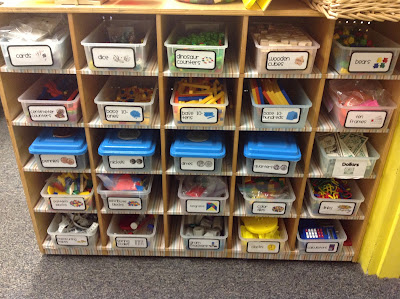This year, I have fully embraced math practice strategy #5 - Using appropriate tools strategically. Students, and not the teachers, need to be using the tools more strategically.
In the past, I thought I was doing well by exposing my students to many different manipulatives and tools to solve math problems. Many mornings were spent filling individual baggies for each student and lessons would often start with, "Pull out your base ten blocks..." I have challenged myself to have the students take more ownership of the tools. This started by changing my math center.
This summer, I made all new labels for my containers. Each label has a picture for those students who still struggle with reading. Removing the lids has led to an increase in student usage because the materials in the containers are visible.
The next goal was for students to get what they needed without prompting.
It started the first week of school by modeling whole group questions such as, "How am I going to solve this problem? Are there any tools I can use?" Then, students would go and get the recommended tool and I modeled proper usage.
Continuing this strategy, I moved to asking the students to come up with a list of tools they could use to solve the problem. Several students moved straight to drawing pictures as their tool. Other students continued to use manipulatives. The class would do a "gallery walk" to find all the different tools used. The lesson often concluded with, "Which tool do you think was most effective?"
The next step was my favorite because it involved several awkward whole class moments. I posed a problem and then proceeded to stare blankly at the students. Finally, I would exclaim, "I just don't know where to begin. What should I do first? Let's just guess." My patience set in until a student would say, "No, no, no. Why don't you try using ______?" Cartwheels and clapping would ensue, the problem would sometimes get solved. If the chosen tool did not help to solve the problem, the process would begin again and would continue until we knew we had the best possible answer. I watched as students started to own the tools.
At this point in the year, most students were very comfortable using tools to solve a problem. There were still individual students who did not grasp the concept. These students needed individual attention which started with, "So tell me what tools you have tried to use to solve this problem." This tiny clue was often the key they needed to unlock the problem solving mystery.
It is now January, and my students have finally reached independence. Yes, it took that long, but it was well worth every long and painful moment. Any time a math problem is discussed, students are free to get any materials they deem necessary to complete the question. During a recent principal observation, my students grabbed 5 different manipulatives and they were all beneficial in solving the problem. I did not waste any class time handing out materials or making baggies of counters prior to the lesson. I call that success.


cartwheels? on your part or theirs? love love love this post. I learned math with blocks of beads, bars of beads and individual beads. you brought me back Ms. Anne ;)
ReplyDelete